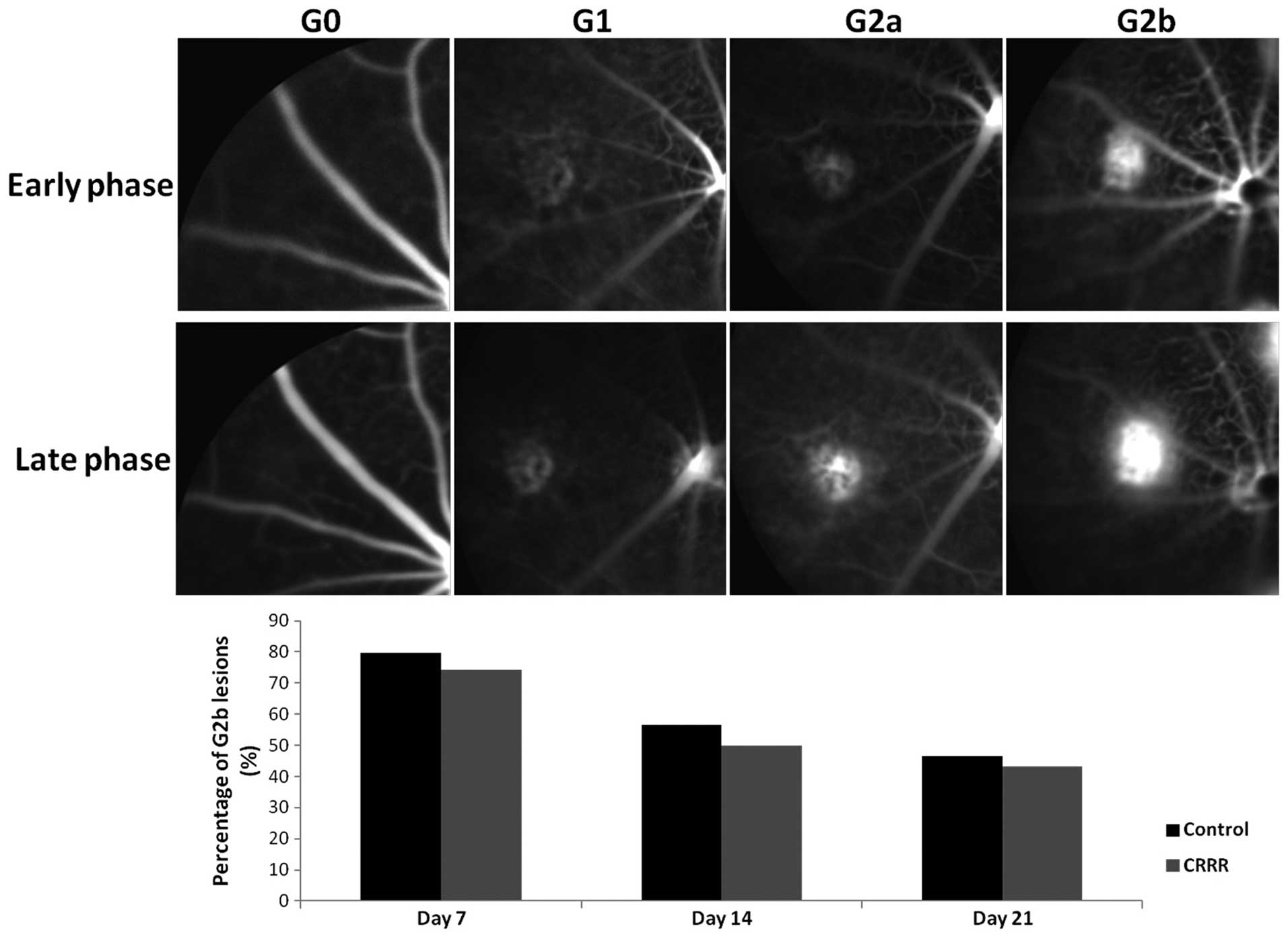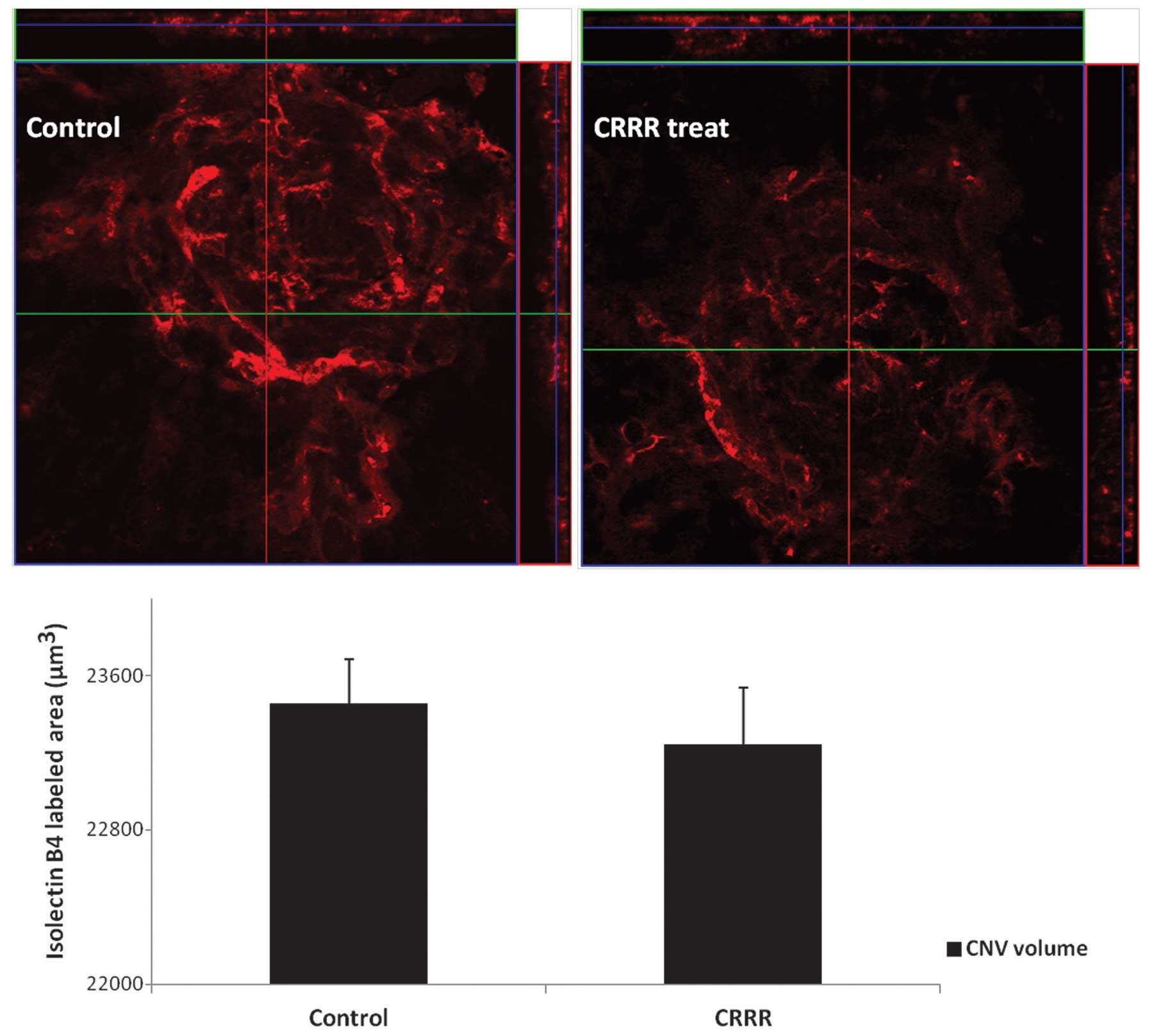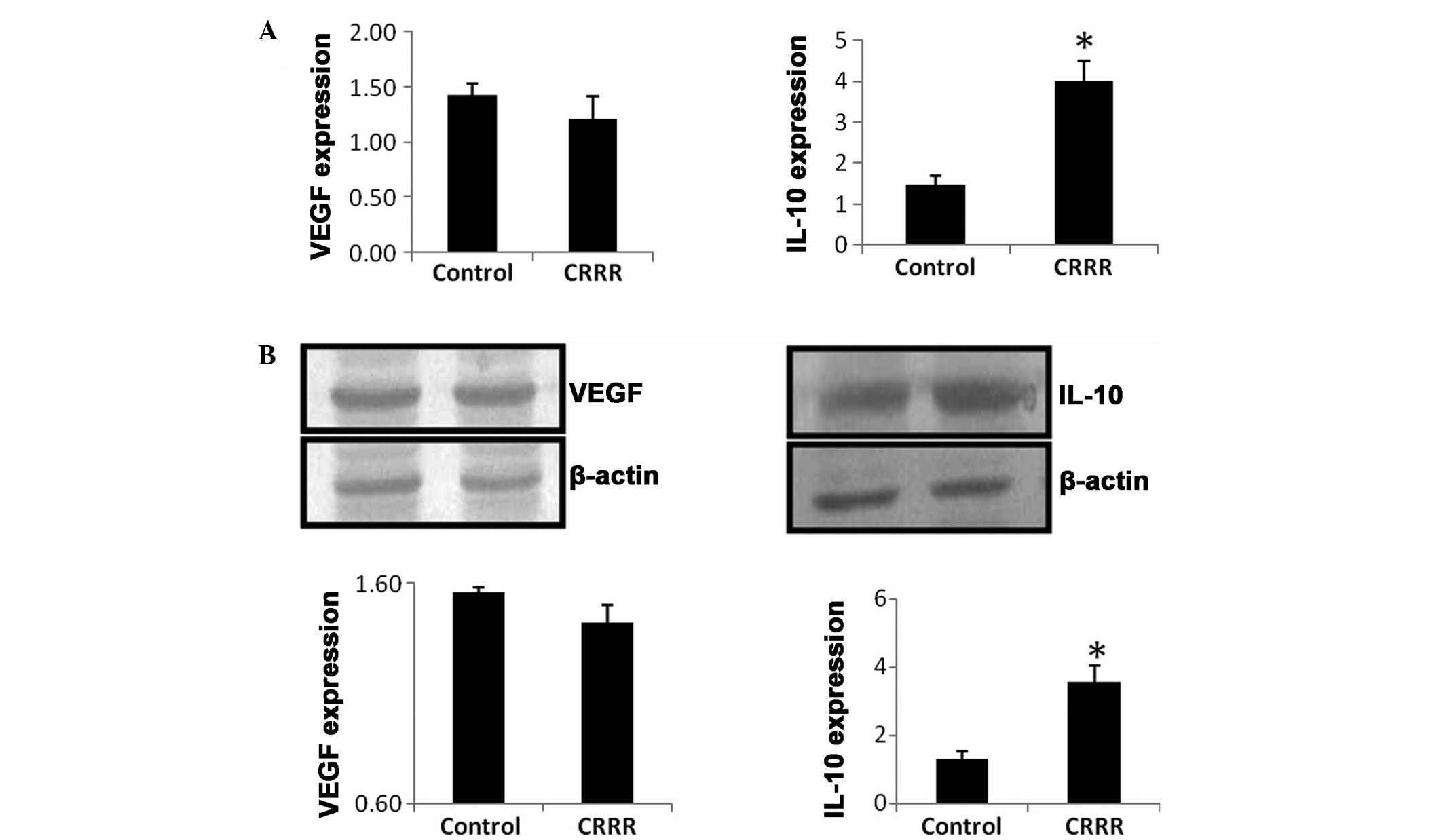|
1
|
Klein R, Peto T, Bird A and Vannewkirk MR:
The epidemiology of age-related macular degeneration. Am J
Opthalmol. 137:486–495. 2004. View Article : Google Scholar
|
|
2
|
Jian L, Panpan Y and Wen X: Current
choroidal neovascularization treatment. Ophthalmologica. 230:55–61.
2013. View Article : Google Scholar : PubMed/NCBI
|
|
3
|
Campagne MVL, LeCouter J, Yaspan BL and Ye
W: Mechanisms of age-related macular degeneration and therapeutic
opportunities. J Pathol. 232:151–164. 2014. View Article : Google Scholar
|
|
4
|
Jin M: Pharmaceutical composition for
treating macular degeneration. International patent WO/2012/079419.
Filed October 13, 2011; issued June 21, 2012.
|
|
5
|
Wang S and Cunnusamy K: Pharmaceutical
composition for treating macular degeneration (W02012079419).
Expert Opin Ther Pat. 23:269–272. 2013. View Article : Google Scholar :
|
|
6
|
Marneros AG, She H, Zambarakji H,
Hashizume H, Connolly EJ, Kim I, Gragoudas ES, Miller JW and Olsen
BR: Endogenous endostatin inhibits choroidal neovascularization.
FASEB J. 21:3809–3818. 2007. View Article : Google Scholar : PubMed/NCBI
|
|
7
|
Matsumara N, Kamei M, Tsujikawa M, et al:
Low-dose lipopolysaccharide pretreatment suppresses choroidal
neovascularization via IL-10 induction. PLoS One. 7:e398902012.
View Article : Google Scholar
|
|
8
|
Andrews NC and Faller DV: A rapid
micropreparation technique for extraction of DNA-binding proteins
from limiting numbers of mammalian cells. Nucleic Acids Res.
19:24991991. View Article : Google Scholar : PubMed/NCBI
|
|
9
|
Ferris FL III, Fine SL and Hyman L:
Age-related macular degeneration and blindness due to neovascular
maculopathy. Arch Ophthalmol. 102:1640–1642. 1984. View Article : Google Scholar : PubMed/NCBI
|
|
10
|
Veritti D, Sarao V and Lanzetta P:
Neovascular age-related macular degeneration. Ophthalmologica.
227:11–20. 2012. View Article : Google Scholar : PubMed/NCBI
|
|
11
|
Li Y, Huang D, Xia X, Wang Z, Luo L and
Wen R: CCR3 and choroidal neovascularization. PLoS One.
6:e171062011. View Article : Google Scholar : PubMed/NCBI
|
|
12
|
Arias l, Garcia-Arumi J, Ramon JM, et al:
Photodynamic therapy with intravitreal triamcinolone in
predominantly classic choroidal neovascularization: one-year
results of a randomized study. Opthalmology. 113:2243–2250. 2006.
View Article : Google Scholar
|
|
13
|
Challa JK, Gillies MC, Penfold PL, et al:
Exudative macular degeneration and intravitreal tramcinolone: 18
month follow up. Aust N Z J Opthalmol. 26:277–281. 1998. View Article : Google Scholar
|
|
14
|
Regillo CD, Brown DM, Abraham P, Yue H,
Ianchulev T, Schneider S and Shams N: Randomized, double-masked,
sham-controlled trial of ranibizumab for neovascular age-related
macular degeneration: PIER Study year 1. Am J Ophthalmol.
145:239–248. 2008. View Article : Google Scholar : PubMed/NCBI
|
|
15
|
Nishijima K, Ng YS, Zhong L, Bradley J,
Schubert W, Jo N, Akita J, Samuelsson SJ, Robinson GS, Adamis AP
and Shima DT: Vascular endothelial growth factor-A is a survival
factor for retinal neurons and a critical neuroprotectant during
the adaptive response to ischemic injury. Am J Pathol. 171:53–67.
2007. View Article : Google Scholar : PubMed/NCBI
|
|
16
|
Robinson GS, Ju M, Shih SC, Xu X, McMahon
G, Caldwell RB and Smith LE: Nonvascular role for VEGF: VEGFR-1, 2
activity is critical for neural retinal development. FASEB J.
15:1215–1217. 2001.PubMed/NCBI
|
|
17
|
Ueta T, Yanagi Y, Tamaki Y and Yamaguchi
T: Cerebrovascular accidents in ranibizumab. Ophthalmology.
116:3622009. View Article : Google Scholar : PubMed/NCBI
|
|
18
|
Campbell RJ, Bell CM, Paterson JM,
Bronskill SE, Moineddin R, Whitehead M and Gill SS: Stroke rates
after introduction of vascular endothelial growth factor inhibitors
for macular degeneration: a time series analysis. Ophthalmology.
119:1604–1608. 2012. View Article : Google Scholar : PubMed/NCBI
|
|
19
|
Horsley MB, Mandava N, Maycotte MA and
Kahook MY: Retinal nerve fiber layer thickness in patients
receiving chronic anti-vascular endothelial growth factor therapy.
Am J Ophthalmol. 150:558–561. 2010. View Article : Google Scholar : PubMed/NCBI
|
|
20
|
Zhou QB, Anderson C, Zhang H, Li X, Inglis
F, Jayagopal A and Wang SS: Repression of choroidal
neovascularization through actin cytoskeleton pathways by
mircoRNA-24. Mol Ther. 22:378–389. 2014. View Article : Google Scholar :
|
|
21
|
Schaal S, Kaplan HJ and Tezel TH: Is there
tachyphylaxis to intravitreal anti-vascular endothelial growth
factor pharmacotherapy in age related macular degeneration?
Ophthalmology. 115:2199–2205. 2008. View Article : Google Scholar : PubMed/NCBI
|
|
22
|
Dhalla MS, Shah GK, Blinder KJ, et al:
Combined photodynamic therapy with verteporfin and intravitreal
bevacizumab for choroidal neovascularization in age-related macular
degeneration. Retina. 26:988–993. 2006. View Article : Google Scholar : PubMed/NCBI
|
|
23
|
Ebrahim S, Peyman GA and Lee PJ:
Applications of liposomes in ophthalmology. Surv Ophthalmol.
50:167–182. 2005. View Article : Google Scholar : PubMed/NCBI
|
|
24
|
Ko JK and Chik CW: The protective action
of radix Astragalus membranaceus against hapten-induced colitis
through modulation of cytokines. Cytokine. 47:85–90. 2009.
View Article : Google Scholar : PubMed/NCBI
|
|
25
|
Han C and Guo J: Antibacterial and
anti-inflammatory activity of traditional Chinese herb pairs,
Angelica sinensis and Sophora flavescens. Inflammation. 35:913–919.
2012. View Article : Google Scholar
|
|
26
|
Chang SH, Choi Y, Park JA, et al:
Anti-inflammatory effects of BT-201, an n-butanol extract of Panax
notoginseng, observed in vitro and in a collagen-induced arthritis
model. Clin Nutr. 26:785–791. 2007. View Article : Google Scholar : PubMed/NCBI
|
|
27
|
Fuchs SM, Heinemann C, Schliemann-Willers
S, et al: Assessment of anti-inflammatory activity of Poria cocos
in sodium lauryl sulphate-induced irritant contact dermatitis. Skin
Res Technol. 12:223–227. 2006. View Article : Google Scholar : PubMed/NCBI
|
|
28
|
Cho IH, Lee MJ, Kim JH, Han NY, Shin KW,
Sohn Y and Jung HS: Fritillaria ussuriensis extract inhibits the
production of inflammatory cytokine and MAPKs in mast cells. Biosci
Biotechnol Biochem. 75:1440–1445. 2011. View Article : Google Scholar : PubMed/NCBI
|
|
29
|
Mandal MN, Patlolla JM, Zheng L, et al:
Curcumin protects retinal cells from light-and oxidant
stress-induced cell death. Free Radic Biol Med. 46:672–679. 2009.
View Article : Google Scholar : PubMed/NCBI
|
|
30
|
Lee HS, Lee MJ, Kim H, et al: Curcumin
inhibits TNFalpha-induced lectin-like oxidised LDL receptor-1
(LOX-1) expression and suppresses the inflammatory response in
human umbilical vein endothelial cells (HUVECs) by an antioxidant
mechanism. J Enzyme Inhib Med Chem. 25:720–729. 2010. View Article : Google Scholar : PubMed/NCBI
|
|
31
|
Yang WJ, Li DP, Li JK, et al: Synergistic
antioxidant activities of eight traditional Chinese herb pairs.
Biol Pharm Bull. 32:1021–1026. 2009. View Article : Google Scholar : PubMed/NCBI
|
|
32
|
Yang X, Zhao Y, Zhou Y, et al: Component
and antioxidant properties of polysaccharide fractions isolated
from Angelica sinensis (OLIV.) DIELS. Biological Pharmaceutical
Bulletin. 30:1884–1890. 2007. View Article : Google Scholar : PubMed/NCBI
|
|
33
|
Jang YJ, Kim ME and Ko SY: n-Butanol
extracts of Panax notoginseng suppress LPS-induced MMP-2 expression
in periodontal ligament fibroblasts and inhibit osteoclastogenesis
by suppressing MAPK in LPS-activated RAW264.7 cells. Arch Oral
Biol. 56:1319–1327. 2011. View Article : Google Scholar : PubMed/NCBI
|
|
34
|
Choi RC, Jiang Z, Xie HQ, et al:
Anti-oxidative effects of the biennial flower of Panax notoginseng
against H2O2-induced cytotoxicity in cultured
PC12 cells. Chin Med. 5:382010. View Article : Google Scholar
|
|
35
|
Kanayama H, Adachi N and Togami M: A new
antitumor polysaccharide from the mycelia of Poria cocos Wolf. Chem
Pharm Bull. 31:1115–1118. 1983. View Article : Google Scholar : PubMed/NCBI
|
|
36
|
Seo JS, Jung EY, Kim JH, et al: A modified
preparation (LMK03) of the oriental medicine Jangwonhwan reduces
Abeta (1–42) level in the brain of Tg-APPswe/PS1dE9 mouse model of
Alzheimer disease. J Ethnopharmacol. 130:578–585. 2010. View Article : Google Scholar : PubMed/NCBI
|
|
37
|
Li Z, Xia X, Zhang S, et al: Up-regulation
of Toll-like receptor 4 was suppressed by emodin and baicalin in
the setting of acute pancreatitis. Biomed Pharmacother. 63:120–128.
2009. View Article : Google Scholar
|
|
38
|
Zhang L, Yang Y, Wang Y and Gao X:
Astragalus membranaceus extract promotes neovascularisation by VEGF
pathway in rat model of ischemic injury. Pharmazie. 66:144–150.
2011.PubMed/NCBI
|
|
39
|
Lam HW, Lin HC, Lao SC, et al: The
angiogenic effects of Angelica sinensis extract on HUVEC in vitro
and zebrafish in vivo. J Cell Biochem. 103:195–211. 2008.
View Article : Google Scholar
|
|
40
|
Yeh JC, Cindrova-Davies T, Belleri M, et
al: The natural compound n-butylidenephthalide derived from the
volatile oil of Radix Angelica sinensis inhibits angiogenesis in
vitro and in vivo. Angiogenesis. 14:187–197. 2011. View Article : Google Scholar : PubMed/NCBI
|
|
41
|
Ohkura N, Tauchi C, Nakayama A and Atsumi
G: Pollen Typhae is a rapid hemostyptic. Blood Coagul Fibrinolysis.
23:254–255. 2012. View Article : Google Scholar : PubMed/NCBI
|
|
42
|
Ding JD, Johnson LV, Herrmann R, et al:
Anti-amyloid therapy protects against retinal pigmented epithelium
damage and vision loss in a model of age-related macular
degeneration. Proc Natl Acad Sci USA. 108:E279–E287. 2011.
View Article : Google Scholar : PubMed/NCBI
|
|
43
|
Lei ZQ: Chinese herbs/Da Huang. Chinese
Medicine. Chen SY and Gao XY: 1st edition. Shanghai Science and
Technology Publisher; Shanghai: pp. 176–182. 1998, (In
Chinese).
|
|
44
|
Gan T, Liu YD, Wang Y and Yang J:
Traditional Chinese Medicine herbs for stopping bleeding from
haemorrhoids. Cochrane Database Syst Rev.
10:CD0067912010.PubMed/NCBI
|
|
45
|
Kumar A, Dhawan S and Aggarwal BB: Emodin
(3-methyl-1,6,8-trihydroxyanthraquinone) inhibits TNF-induced NF-κB
activation, IκB degradation and expression of cell surface adhesion
proteins in human vascular endothelial cells. Oncogene. 17:913–918.
1998. View Article : Google Scholar : PubMed/NCBI
|
|
46
|
Saraiva M and O’Garra A: The regulation of
IL-10 production by immune cells. Nat Rev Immunol. 10:170–181.
2010. View Article : Google Scholar : PubMed/NCBI
|
|
47
|
Apte RS, Richter J, Herndon J and Ferguson
TA: Macrophages inhibit neovascularization in a murine model of
age-related macular degeneration. PLoS Med. 3:e3102006. View Article : Google Scholar : PubMed/NCBI
|
|
48
|
Hasegawa E, Oshima Y, Takeda A, Saeki K,
Yoshida H, et al: IL-27 inhibits pathophysiological intraocular
neovascularization due to laser burn. J Leukoc Biol. 91:267–273.
2012. View Article : Google Scholar
|
|
49
|
Tsang KW, Lam CL, Yan C, et al: Coriolus
Versicolor Polysaccharide Peptide slows progression of advanced
non-small cell lung cancer. Respir Med. 97:618–624. 1997.
View Article : Google Scholar
|
|
50
|
Lee KH: Research and future trends in the
pharmaceutical development of medicinal herbs from Chinese
medicine. Public Health Nutr. 3:515–522. 2000. View Article : Google Scholar
|












